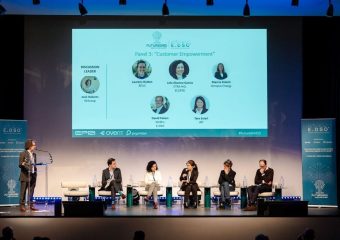On 30 March 2022, E.DSO Policy & Regulation Committee held virtually an internal workshop dedicated to future distribution network tariffs structures. The workshop was moderated by Tzeni Varfi, Policy & Legal Director at E.DSO.
This workshop was organised to respond to the rising interest by E.DSO members in the developments of tariff structures and to different stakeholders who approached the Secretariat during the past half-year to ask about insights about E.DSO viewpoint on the topic. The workshop comprised the following contributions:

Fons Jansen, Advisor Smart Grids & Europe at Enexis, presented the E.DSO Guidance Paper on Distribution Network Tariff Structures. Fons argued that the ideal distribution network tariff structure does not exist. The most robust choice for the network tariff structure, being it power-based with or without a volumetric or fixed tariff component or a combination of those, depends on the context to which it is applied. As a general statement, an ideal network tariff should comply with different principles as included in the above Guidance, namely: (1) Cost reflectiveness, (2) Fairness, (3) Non-discriminatory, (4) Incentives for efficient network use (5) Transparency and understandability, (6) Implementability, (7) Limited complexity. An appropriate tariff structure can prevent a lot of problems, also problems related to the energy transition.
Fons further introduced the Bandwidth tariff model that probably will be adopted in the Netherlands, where customers ask for a certain capacity bandwidth and pay a fee if they use additional energy beyond their allocation. This model provides a fair allocation of cost and allows for efficient utilisation of the grid, maximising use, and minimising demand for capacity growth.
In the bandwidth model each customer subscribes to a certain capacity within which energy can be used at no volumetric charge. If more is used an additional fee is levied based on the level and duration of exceedance, although these instances could be mitigated with a home battery or reduced EV charging power rates.
Enexis believes that this model is future-proof, cost-effective, and more importantly, it is fair. But the exceedance fee needs to be carefully adjusted to provide an incentive, thus the calibration of the exceedance is very important (not very high so customers select a high subscribed capacity, or too low to remove the incentive for peak shaving).

Santiago Gallego, Networks Regulation Manager at i-DE (Iberdrola), presented Spain’s new network tariffs which came into force on 1 June 2021. Under this new tariff model, all network users in Spain have prices differentiated by hourly time brackets, both for power and consumption. In the case of domestic customers, there are 2 periods for the contracted power, while consumption is differentiated into 3 different billing periods:
- off-peak: this is the cheapest period and includes night hours with lower electricity consumption, from midnight to 8am, as well as any time on Saturday and Sunday and public holidays.
- peak: this is the most expensive period and ranges from 10am to 2pm and from 6pm to 10pm.
- flat: This period maintains an intermediate price and ranges from 8am to 10am, 2pm to 6pm and from 10pm to midnight.
According to i-DE, the static Time-of-Use tariff improves cost-reflectiveness and provide better price signals than flat tariffs. Additionally, it helps make network operation and planning more efficient, and, eventually, avoid congestion. The value of this tariff is also considered in relation to specific uses, such as electric vehicles or heat pumps, which can be used in off-peak periods.






